Digilent Microchip PIC32MX795F512 32位MCU开发方案
2012年02月09日 17:32 发布者:1770309616
Microchip公司的PIC32MX795F512是集成了USB,CAN和以太网的32位闪存MCU,32位RISC CPU最高频率80MHz,MCU工作电压2.3V-3.6V,具有64KB-512KB闪存和16KB到128KB SRAM,而Digilent公司的Cerebot MX7cK MCU开发板采用PIC32MX795F512L,和Pmod™外设模块兼容,并适合和Microchip MPLAB® IDE工具一起使用,也适合和chipKIT™ MPIDE开发环境一起使用.本文首先介绍了PIC32MX795F512主要特性和方框图,接着介绍Cerebot MX7cK MCU开发板主要特性和详细电路图.The Cerebot MX7cK is a microcontroller development board based on the Microchip PIC32MX795F512L.
PIC32MX795F512主要特性:
High-Performance 32-bit RISC CPU:
• MIPS32® M4K® 32-bit core with 5-stage pipeline
• 80 MHz maximum frequency
• 1.56 DMIPS/MHz (Dhrystone 2.1) performance at zero Wait state Flash access
• Single-cycle multiply and high-performance divide unit
• MIPS16e® mode for up to 40% smaller code size
• Two sets of 32 core register files (32-bit) to reduce interrupt latency
• Prefetch Cache module to speed execution from Flash
Microcontroller Features:
• Operating voltage range of 2.3V to 3.6V
• 64K to 512K Flash memory (plus an additional 12 KB of Boot Flash)
• 16K to 128K SRAM memory
• Pin-compatible with most PIC24/dsPIC® DSC devices
• Multiple power management modes
• Multiple interrupt vectors with individually programmable priority
• Fail-Safe Clock Monitor mode
• Configurable Watchdog Timer with on-chip
Low-Power RC oscillator for reliable operation
Peripheral Features:
• Atomic SET, CLEAR and INVERT operation on select peripheral registers
• Up to 8-channels of hardware DMA with automatic data size detection
• USB 2.0-compliant full-speed device and On-The-Go (OTG) controller:
- Dedicated DMA channels
• 10/100 Mbps Ethernet MAC with MII and RMII interface:
- Dedicated DMA channels
• CAN module:
- 2.0B Active with DeviceNet™ addressing support
- Dedicated DMA channels
• 3 MHz to 25 MHz crystal oscillator
Peripheral Features (Continued):
• Internal 8 MHz and 32 kHz oscillators
• Six UART modules with:
- RS-232, RS-485 and LIN support
- IrDA® with on-chip hardware encoder and decoder
• Up to four SPI modules
• Up to five I2C™ modules
• Separate PLLs for CPU and USB clocks
• Parallel Master and Slave Port (PMP/PSP) with 8-bit and 16-bit data, and up to 16 address lines
• Hardware Real-Time Clock and Calendar (RTCC)
• Five 16-bit Timers/Counters (two 16-bit pairs combine to create two 32-bit timers)
• Five Capture inputs
• Five Compare/PWM outputs
• Five external interrupt pins
• High-speed I/O pins capable of toggling at up to 80 MHz
• High-current sink/source (18 mA/18 mA) on all I/O pins
• Configurable open-drain output on digital I/O pins
Debug Features:
• Two programming and debugging Interfaces:
- 2-wire interface with unintrusive access and real-time data exchange with application
- 4-wire MIPS® standard enhanced Joint Test Action Group (JTAG) interface
• Unintrusive hardware-based instruction trace
• IEEE Standard 1149.2 compatible (JTAG) boundary scan
Analog Features:
• Up to 16-channel, 10-bit Analog-to-Digital Converter:
- 1 Msps conversion rate
- Conversion available during Sleep and Idle
• Two Analog Comparators
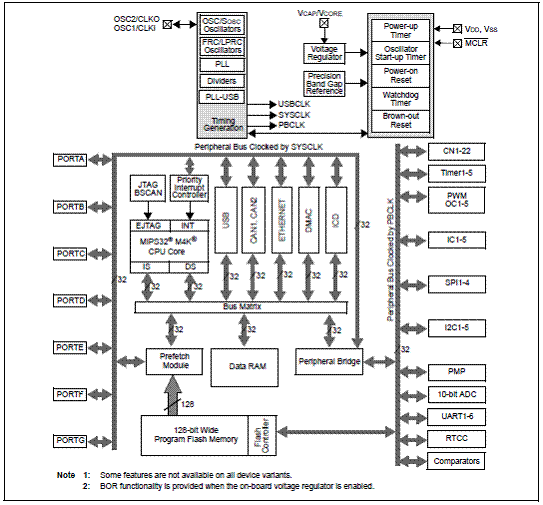
图1. PIC32MX5XX/6XX/7XX系列框图
Cerebot MX7cK MCU开发板
The Cerebot MX7cK is a microcontroller development board based on the Microchip PIC32MX795F512L, a member of the 32-bit PIC32 microcontroller family. It is compatible with Digilent’s line of Pmod™ peripheral modules, and is suitable for use with the Microchip MPLAB® IDE tools. The Cerebot MX7cK is also compatible for use with the chipKIT™ MPIDE development environment.
ChipKIT and MPIDE is a PIC32 based system compatible with many existing Arduino™ code examples,reference materials and other resources.
The Cerebot MX7cK is designed to be easy to use and suitable for use by anyone from beginners to advanced users for experimenting with embedded control and network communications application. A built in programming/debugging circuit compatible with the Microchip MPLAB® IDE is provided, so no additional hardware is required for use with MPLAB. The kit contains everything needed to start developing embedded applications using either the MPLAB® IDE or the MPIDE.
The Cerebot MX7cK provides 52 I/O pins that support a number of peripheral functions, such as UART, SPI and I2C™ ports as well as five pulse width modulated outputs and five external interrupt inputs. Its network and communications features also include a 10/100 Ethernet interface, Full Speed USB 2.0 OTG interface, and dual CAN network interfaces.
Ten of the I/O pins can be used as analog inputs in addition to their use as digital inputs and outputs.
The Cerebot MX7cK can be powered in various ways via USB, or using an external AC-DC power adapter.
Cerebot MX7cK MCU开发板主要特性:
a PIC32MX795F512L microcontroller
support for programming and debugging within the Microchip MPLAB development environment
six Pmod connectors for Digilent peripheral module boards
10/100 Ethernet
USB 2.0 Device, Host, and OTG support
two CAN network interfaces
three push buttons
four LEDs
multiple power supply options, including USB powered
ESD protection and short circuit protection for all I/O pins.
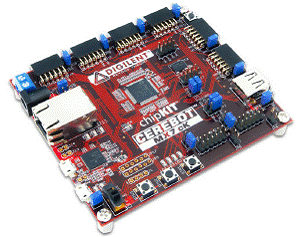
图2.Cerebot MX7cK MCU开发板外形图
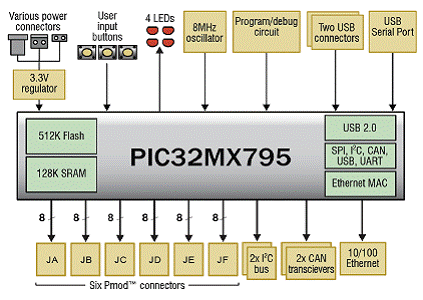
图3.Cerebot MX7cK MCU开发板方框图

图4.Cerebot MX7cK MCU开发板电路图(1)
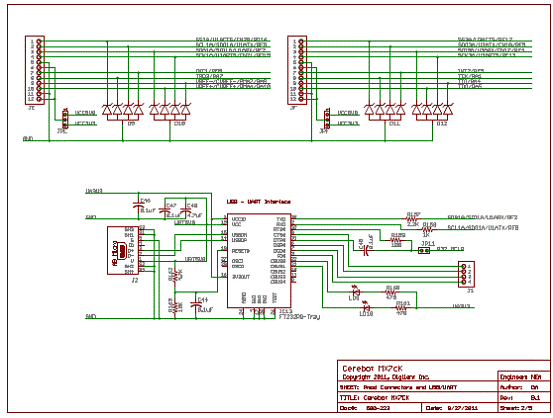
图5.Cerebot MX7cK MCU开发板电路图(2)
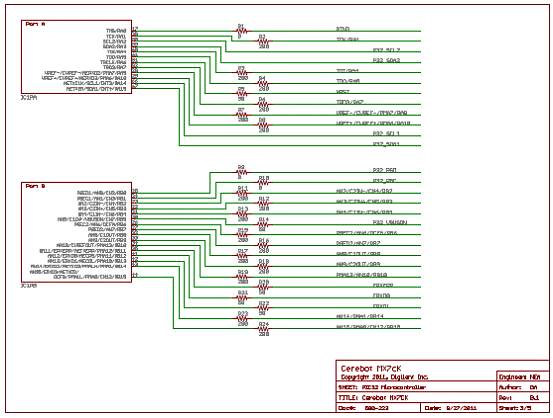
图6.Cerebot MX7cK MCU开发板电路图(3)
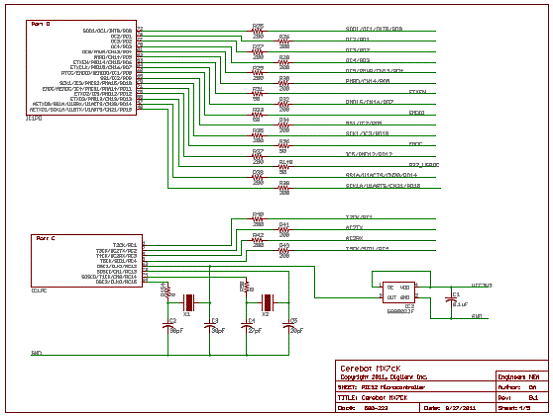
图7.Cerebot MX7cK MCU开发板电路图(4)
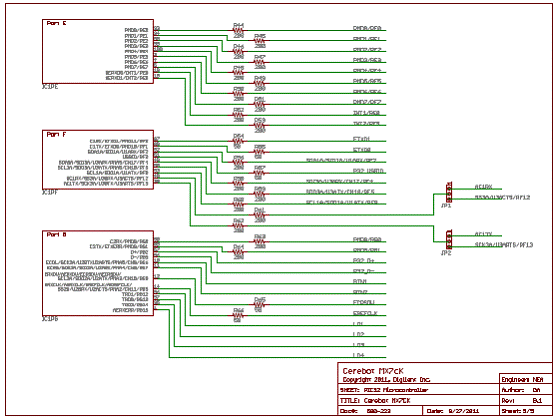
图8.Cerebot MX7cK MCU开发板电路图(5)
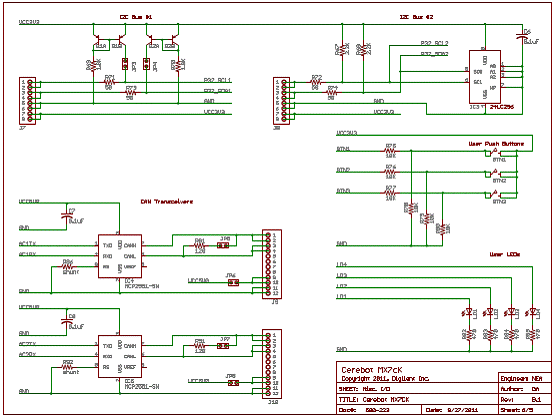
图9.Cerebot MX7cK MCU开发板电路图(6)
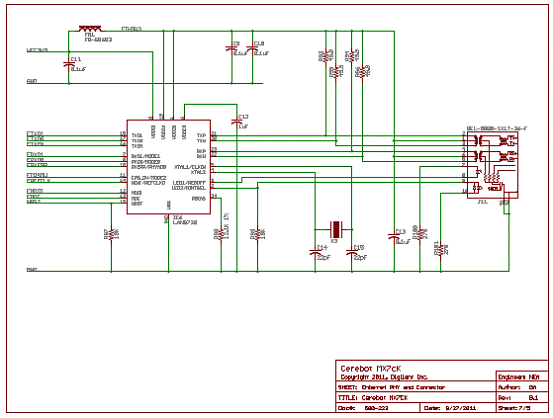
图10.Cerebot MX7cK MCU开发板电路图(7)
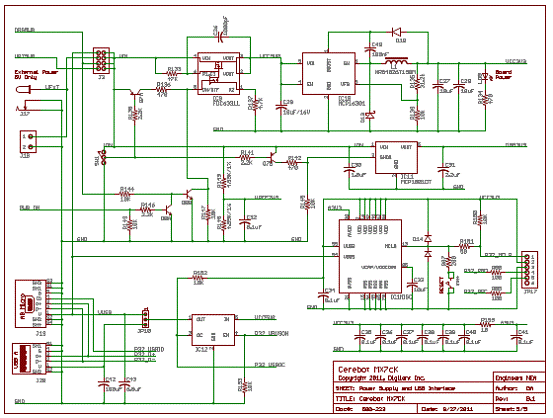
图11.Cerebot MX7cK MCU开发板电路图(8)
详情请见:
64847和
64848以及
64849
